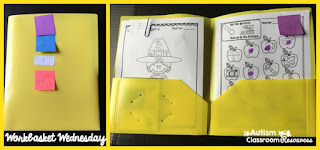During this installment of the Around Town Roundup we would like to cover one of our favorite teaching supports, Structured Work Systems. A Structured Work System is a component of the structured teaching model developed by the TEACCH program at the University of North Carolina, Chapel Hill. It is a way to bring predictability and meaning to the tasks a student needs to complete in the classroom. It tells the students what they will be doing once in a given location or in a given time frame. The work system clarifies information for the student.
The work
system tells the student
- How much work
- What work
- When the work will be finished
- What comes next
We have seen a variety of work systems when we have been in classrooms. Here are some examples of the traditional set up. In these examples, students follow the visual number or shape schedule to match the first card to the corresponding tub, take the tub from the shelf, complete the work inside the tub, and place it in the finished bin. When all tubs are completed and moved to the finished bin, the student knows they are finished.
 |
| Emily Ottmar, Stevenson Elementary, Mad River Local Schools |
Sometimes students may need some visual reminders to cue them if they need help, need a missing material, or what to tell staff they are finished. There cue cards are velcro'd to the wall so they can serve as reminders and/or be exchanged with staff.
For older students, you can use a small desk shelf.
 |
| Rebecca Lemons, Miamisburg Middle School |
In some classrooms there may not be enough room for a traditional work system set up or you may want to increase independence through having students locate their own work tasks. In some classrooms, students are given a schedule of Ellison cut outs, picture cards, or colored picture icons that they need to match to the corresponding bin on a larger shelf.
 |
| Jamie Zimmer, Kettering Middle School |
 |
| Emily Ottmar, Stevenson Elementary |
To assist staff with knowing what work tasks are assigned to each student one teacher places their icon schedules on a bulletin board and staff moves the sequence of icons to the table when it is their turn for structured work:
 |
| Emily Ottmar, Stevenson Elementary |
In this classroom, each student has their own visual contract or "I do, I get" folder in which icons can be placed on for students to match for completion and then they choose a reinforcing activity to take a break.
 |
| Jody Chick, Yellow Springs High School |
In this high school classroom, students have a clipboard of tasks written out that they have to locate and complete. They can independently find their assignments on this shelf which has a mix of taskboxes, file folders, and manila envelope tasks.
 |
| Robbie Whorton, Trotwood High School |
Sometimes space does not allow for a shelf of work tasks in the classroom and therefore staff needs to rotate which boxes are available. In this classroom, the teacher has a set of 12 bins that can be changed out to hold different tasks each day or week.
 |
| Kate Tipple, Helke Elementary |
Sometimes students are able to transition to more advanced work systems which may be more paper-pencil, file folder, or task card activities. These are also great for students in inclusive students who need a structured approach to completing independent work.
In this example, they used numbered stacking trays and student worksheets were kept in the pocket file to the left for easy set up.
This example has a binder with pockets for worksheets. The final page is a reinforcement menu for the student to earn a break.
The following examples are from one of our favorite bloggers, Christine Reeve at Autism Classroom Resources. She shows examples of a folder system with post-it note schedule and a multi-folder binder system. For more examples from Christine, check out her blog post on Advanced Structured Work Systems.
Other teachers have applied the concept of structured work systems to presenting tasks during class activities in a 1:1, small group, or whole group setting.
In these examples, teachers use a drawer system to present tasks
 |
| Katie Bigelow & Casey Lathrop, Brookville Elementary |
Other classrooms have bins matching the designated number of tasks that can be moved to the floor or finished bin to visually show students when they are completed.
 |
| Emily Ottmar, Stevenson Elementary |
 |
| Brittany Bush, Spinning Hills Middle School |
For more information, visit UNC's TEACCH Autism Program site or the Autism Internet Module for Structured Work Systems and Activity Organization.












No comments:
Post a Comment